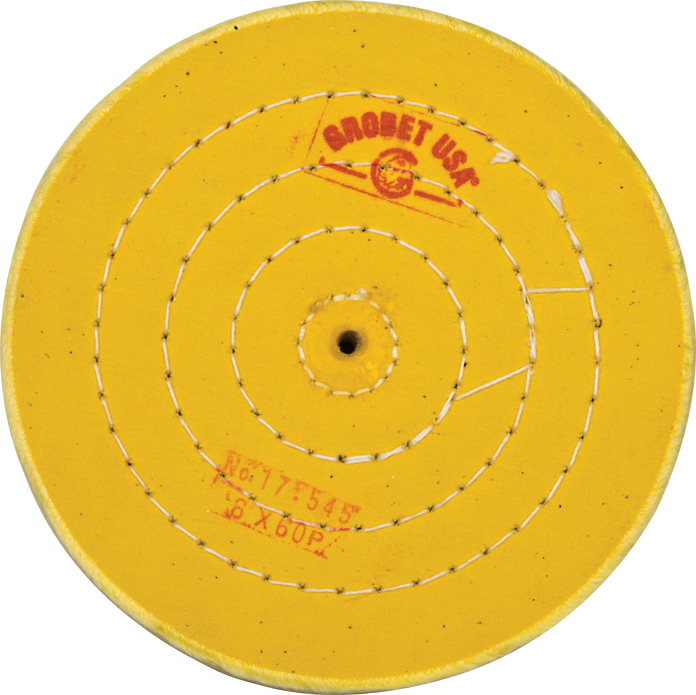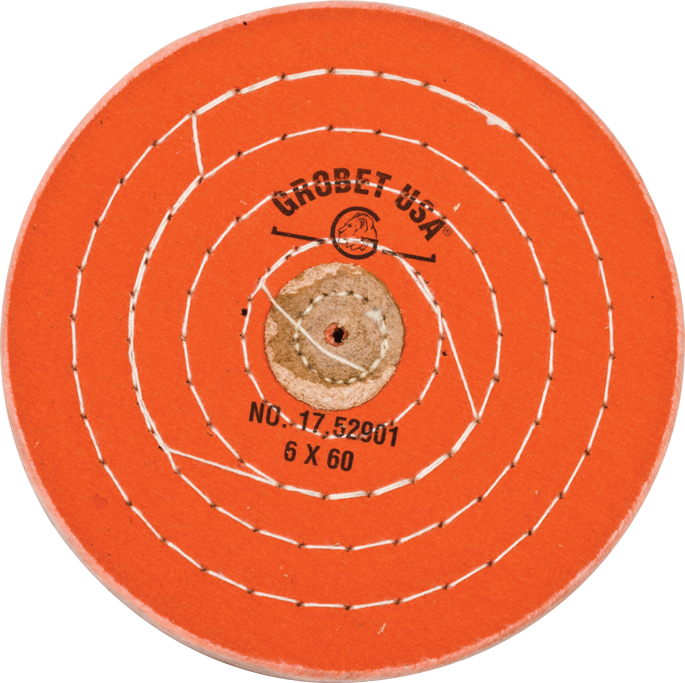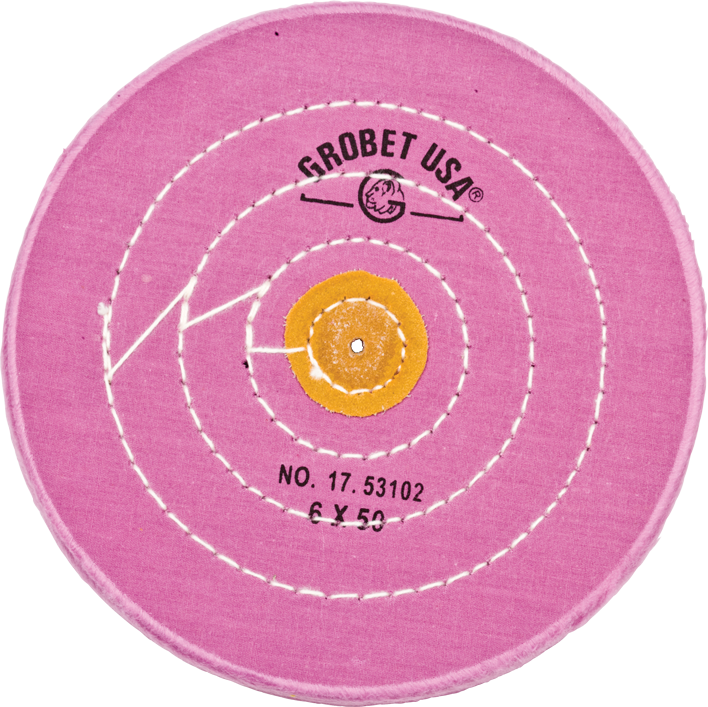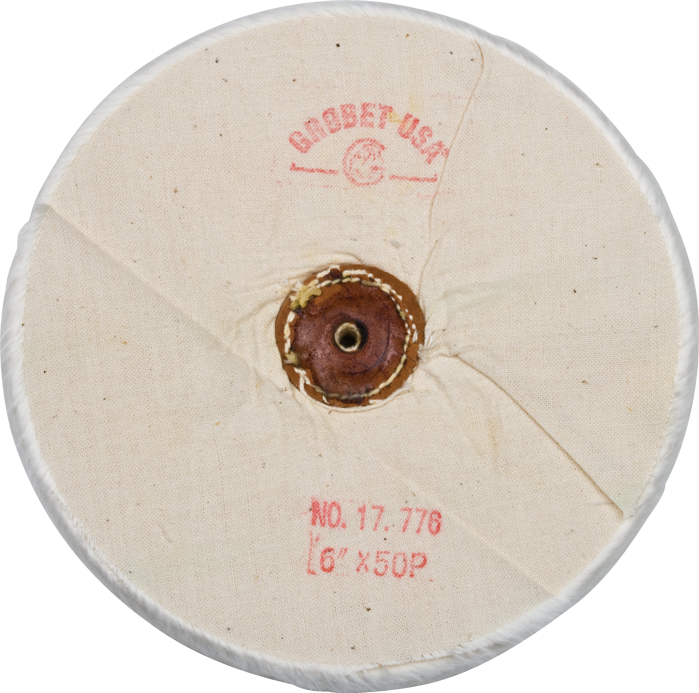
A polishing compound here. A muslin buff over there. And while looking at the buff you really needed, you accidentally put the wrong compound on the wrong buff. Or maybe some of your workers are using jewelry buffs and polishing compounds with somewhat reckless abandon. And now you’re left with a pile of contaminated shop debris.
If you’ve experienced any of those scenarios, try this process to prevent contamination and to extend the life of your buffs and compounds. In turn, you’ll provide superior finishes on your customers’ jewelry and save money on consumable jewelry supplies.
USING MUSLIN BUFFS
Muslin buffs are typically used with rouge in the final polishing stage. They come in a range of diameters, styles, and ply, making them one of the most useful tools at your bench. Muslin buffs are available in two overall types.
Muslin buffs are either combed or uncombed, which refers to whether you need to break in the buff for it to hold compound.
• Combed muslin buffs do not need breaking in. Combed buffs are great for producing a final high polish.
• Uncombed muslin buffs do need to be broken in. Uncombed buffs are harder than combed buffs, and they’re ideal for removing scratches and for rough finishing.
To use your muslin buff, begin with heavy scratch and scuff mark removal using your treated muslin buffs. Chemically treated muslin buffs provide long wear and retain compound better than untreated buffs.
Muslin buff tip: Mark them on both sides with the number one to ensure your buffs remain separate and don’t contaminate each other.
RECOMMENDED JEWELRY BUFFING WHEELS AND POLISHING COMPOUNDS
Use each muslin buff below with the corresponding polishing compound for best jewelry polishing results.
STAGE ONE: POLISHING

Grobet USA® Chemkote Yellow Treated Muslin Wheel Buff: 17-5566
This 60-ply muslin buff is chemically treated for longevity and has a combed edge, meaning you don’t need to break it in to hold your polishing compound in the wheel. It is ideal for the cutdown procedure when doing heavy, rough work.
Matchless Graystar Polishing Compound: 47-3297
This 800-grit, dry, aggressive polishing compound removes scratches and other imperfections. It leaves a uniform finish on brass, gold, silver, and stainless steel.

Grobet USA® Orange Treated Muslin Wheel Buff: 17-5612
This 60-ply muslin buff works best when used with platinum Tripoli and bobbing compounds.
Matchless Buffing Compound: 47-3291
This 600-grit, aggressive bobbing compound is best for soft metals like gold, silver, aluminum, and brass. When using laps and bristle brushes, it adheres well to the buff. Best for fast, heavy cutting.

Grobet USA® Purple Treated Muslin Wheel Buff: 17-7254
This 50-ply stiff, chemically treated muslin buff is ideal for aggressive compounds and great for platinum work.
Platinum Tripoli Polishing Rouge: 47-3285
This coarse cutting compound removes scratches and surface imperfections on metals like platinum, chromium, stainless steel, and other hard metals. This tripoli cuts similarly to regular tripoli, but it leaves an even brighter finish.
STAGE TWO: BUFFING
Take the metal from a dull luster to a high luster with stitched white muslin buffs. There are a variety of compounds for this stage, green rouge being the most common. Boldly mark all buffs with the number two on both sides. And again — keep these compounds and buffs together.

Grobet USA® White Muslin Buff: 17-5715
This all-purpose buff is ideal for initial polishing and for use with tripoli and bobbing compounds on gold and silver. It’s the industry’s standard buff you know, use, and love.
Matchless Green Polishing Rouge: 47-3211
This medium-fine polishing rouge is specially formulated for polishing silver, stainless steel, platinum, white gold, and rhodium. It produces a high luster and leaves behind little residue, saving you cleanup time.
STAGE THREE: FINAL BUFFING
Bring precious metal to full luster by using loose buffs, which are unstitched and usually made of muslin. There are many compounds used in the final stage, often left up to personal preference.

Grobet Finex Combed Muslin Wheel Buff
Finex muslim is tightly weaved and very soft, making it excellent for use with all types of polishing rouge.
Picasso Blue Platinum Compound
This polishing compound gives an ultra-bright finish for both platinum and gold jewelry. Try it on your white metals and witness what brilliance is all about. (Just remember to mark it with the number three and store it with your final buff compounds.)
FIVE JEWELRY POLISHING TIPS
Finishing can make or break even the most well-crafted piece, so spend some time familiarizing yourself with these tips — and experiment. You might just find a way to improve your polishing process.
• Protect any stones you’re working around. Abrasive compounds can scratch, chip, and dull stones.
• Use plenty of polishing compound on the buffing wheel, and add more compound frequently.
• Avoid contamination by cleaning the piece between cutting and buffing operations. Contaminated buffs can stop the buff from producing the expected finish.
• Start with the flat surface of your workpiece against the wheel, and draw it out to the edge of the wheel. Avoid polishing directly against a corner since it will round off.
• Polish against the point of the “V,” allowing the buff to spread down over it. Never polish down into the “V” since the buff will conform to the shape and cut a groove into the surface.
DONE!
Afterward, create an easy reference chart with what buff goes with which compound, and welcome your staff into your polishing area.
With a few lessons, you can empower them with confidence that the material they’re using is the right one for the job.
The Tools Tech Team experts are here for you. Give them a call at 1-800-877-7777 ext. 4300









